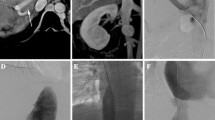Abstract
Purpose
To evaluate the changes in the liver volume and function after direct intrahepatic portocaval shunt (DIPS) in patients with Budd-Chiari syndrome (BCS) with diffuse hepatic vein (HV) occlusion.
Methods
The clinical data of 29 patients with BCS who underwent DIPS for intractable ascites caused by diffuse hepatic vein occlusion in the Affiliated Hospital of Xuzhou Medical University were analysed retrospectively; the patients included 8 males and 21 females, with an average age of 33.3 ± 6.3 years. The patients underwent abdominal CT scanning and liver function examinations before DIPS, and 1 week, 3 months, 6 months and 12 months after DIPS. The changes of the liver volume and liver function before and after DIPS were compared.
Results
All 29 patients underwent DIPS successfully. 28 patients survived during the follow-up of 12–33 months, with a median follow-up of 16 months. The patients’ liver function were significantly improved at 3, 6 and 12 months after the operation compared to before the operation (P < 0.05). The liver volumes measured before the operation and 1 week, 3 months, 6 months and 12 months after the operation were 2124.586 ± 420.889 cm3, 1926.263 ± 372.268 cm3, 1480.592 ± 183.061 cm3, 1461.904 ± 153.027 cm3 and 1469.286 ± 148.549 cm3, respectively. Compared with the preoperative liver volume, the liver volume had decreased significantly at 1 week, 3 months, 6 months and 12 months after the operation (P < 0.05). However, there was no significant difference in the liver volumes at 6 and 12 months after the operation (P = 0.35).
Conclusions
Direct intrahepatic portocaval shunt has achieved satisfactory clinical results in the treatment of BCS with diffuse hepatic vein occlusion. The congestive hepatomegaly was gradually reduced after the operation. The liver volume (which was defined as the clinical efficacy in this study) remained stable after 6 months.
Graphical abstract


Similar content being viewed by others
References
Martens P, Nevens F. Budd-Chiari syndrome. United Eur Gastroenterol J 2015;3: 489-500.
Shin N, Kim YH, Xu H, Shi HB, Zhang QQ, Colon Pons JP, et al. Redefining Budd-Chiari syndrome: a systematic review. World J Hepatol 2016;8: 691-702.
Goel RM, Johnston EL, Patel KV, Wong T. Budd-Chiari syndrome: investigation, treatment and outcomes. Postgrad Med J 2015;91: 692-697.
Moschouri E, Hocquelet A, Vermersch M, Fraga M, Denys A, Artru F. DIPS, a safe and effective alternative in patients with unfavorable anatomy to TIPSS: first experience in a tertiary center. Clin Res Hepatol Gastroenterol 2021;45: 101715.
Cheng D, Xu H, Lu ZJ, Hua R, Qiu H, Du H, et al. Clinical features and etiology of Budd-Chiari syndrome in Chinese patients: a single-center study. J Gastroenterol Hepatol 2013;28: 1061-1067.
Maddrey WC. Hepatic vein thrombosis (Budd-Chiari syndrome). Hepatology 1984;4: 44s-46s.
He F, Zhao H, Dai S, Wu Y, Wang L, Huang H, et al. Transjugular intrahepatic portosystemic shunt for Budd–Chiari syndrome with diffuse occlusion of hepatic veins. Sci Rep 2016;6: 36380.
Rosenqvist K, Sheikhi R, Eriksson LG, Rajani R, Rorsman F, Sangfelt P, et al. Endovascular treatment of symptomatic Budd-Chiari syndrome - in favour of early transjugular intrahepatic portosystemic shunt. Eur J Gastroenterol Hepatol 2016;28: 656-660.
Akamatsu N, Sugawara Y, Kokudo N. Budd-Chiari syndrome and liver transplantation. Intractable Rare Dis Res 2015;4: 24-32.
Cheng DL, Zhu N, Xu H, Li CL, Lv WF, Fang WW, et al. Outcomes of endovascular interventional therapy for primary Budd-Chiari syndrome caused by hepatic venous obstruction. Exp Ther Med 2018;16: 4141-4149.
Qi XS, Ren WR, Fan DM, Han GH. Selection of treatment modalities for Budd-Chiari Syndrome in China: a preliminary survey of published literature. World J Gastroenterol 2014;20: 10628-10636.
Boyvat F, Aytekin C, Harman A, Ozin Y. Transjugular intrahepatic portosystemic shunt creation in Budd-Chiari syndrome: percutaneous ultrasound-guided direct simultaneous puncture of the portal vein and vena cava. Cardiovasc Interv Radiol 2006;29: 857-861.
Boyvat F, Harman A, Ozyer U, Aytekin C, Arat Z. Percutaneous sonographic guidance for TIPS in Budd-Chiari syndrome: direct simultaneous puncture of the portal vein and inferior vena cava. AJR Am J Roentgenol 2008;191: 560-564.
Haskal ZJ, Duszak R, Jr., Furth EE. Transjugular intrahepatic transcaval portosystemic shunt: the gun-sight approach. J Vasc Interv Radiol 1996;7: 139-142.
Branch of Biliary Surgery, Chinese Surgical Society, Chinese Committee of Biliary Surgeons. Guideline for the diagnosis and treatment of gallbladder carcinoma (2019 edition). Zhonghua Wai Ke Za Zhi 2021;37: 30-35.
Hatzidakis A, Galanakis N, Kehagias E, Samonakis D, Koulentaki M, Matrella E, et al. Ultrasound-guided direct intrahepatic portosystemic shunt in patients with Budd-Chiari syndrome: short- and long-term results. Interv Med Appl Sci 2017;9: 86-93.
Hernández-Gea V, De Gottardi A, Leebeek FWG, Rautou PE, Salem R, Garcia-Pagan JC. Current knowledge in pathophysiology and management of Budd-Chiari syndrome and non-cirrhotic non-tumoral splanchnic vein thrombosis. J Hepatol 2019;71: 175-199.
Wakim KG. The blood supply of the normal liver. Meet Mayo Clinic Proc 1953;28: 218-227.
Walser EM, DeLa Pena R, Villanueva-Meyer J, Ozkan O, Soloway R. Hepatic perfusion before and after the transjugular intrahepatic portosystemic shunt procedure: impact on survival. J Vasc Interv Radiol 2000;11: 913-918.
Li YM, lv F, Bai ZL et al. Research and significance of standard liver volume formula of healthy Chinese(in chinese). Shaanxi Med J 2002;31: 634-636.
Author information
Authors and Affiliations
Corresponding author
Ethics declarations
Competing interests
The authors of this work have nothing to disclose.
Additional information
Publisher's Note
Springer Nature remains neutral with regard to jurisdictional claims in published maps and institutional affiliations.
Rights and permissions
Springer Nature or its licensor holds exclusive rights to this article under a publishing agreement with the author(s) or other rightsholder(s); author self-archiving of the accepted manuscript version of this article is solely governed by the terms of such publishing agreement and applicable law.
About this article
Cite this article
Guo, X., Wang, Z., Geng, X. et al. The change in the liver volume after direct intrahepatic portocaval shunt in patients with Budd-Chiari syndrome with diffuse hepatic vein occlusion. Abdom Radiol 48, 291–296 (2023). https://doi.org/10.1007/s00261-022-03683-2
Received:
Revised:
Accepted:
Published:
Issue Date:
DOI: https://doi.org/10.1007/s00261-022-03683-2




